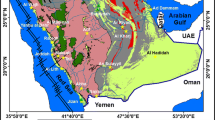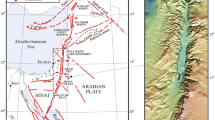Abstract
The occurrence of sinkholes not directly related to karst has been determined in several areas worldwide in recent years. These phenomena may be particularly dangerous to humans and infrastructure due to their subtle origin and need to be carefully examined. In this work, we describe five sinkholes recently identified in a hilly setting of Southern Italy characterized by Pliocene conglomerate and sand, and variously dislocated by tectonic structures. The sinkholes were examined by different methods (interpretation of multi-temporal aerial photos, geological, geomorphological and geophysical surveys). An historical analysis was performed to collect and critically evaluate information regarding the age of the phenomena. Based on this information, it can be conjectured that two of the five sinkholes developed during the 2000–2001 winter; two of the remaining probably originated during the 70s; the last one opened sometime between February 2001 and November 2007. Based on such chronology, attempts have been performed to identify the likely triggers, through hydrological and seismic analyses. In both cases, no immediate correlation could be found. The origin of the studied phenomena remains uncertain, and may be related to sub-cutaneous erosion, in an area that is renowned to be rich in groundwater. Local changes in the water table, related to climate and/or man-induced activities, may have triggered the development of the cover suffusion-type sinkholes. The present work highlights the potential for this type of phenomena to occur in geological settings without the direct presence of soluble rocks at the surface, a condition quite common in Southern Italy, and the need to carry out further studies in order to better comprehend their mechanisms of origin and successive evolution, and to properly evaluate the related hazard.












Similar content being viewed by others
References
Angel JC, Nelson DO, Panno SV (2004) Comparison of a new GIS-based technique and a manual method for determining sinkhole density: an example from Illinois’ sinkhole plain. J Cave Karst Stud 66:9–17
Beck BF (2005) Soil piping and sinkhole failures. In: Culver DC, White WB (eds) Enyclopedia of caves. Elsevier, New York, pp 523–528
Bonaccorso B, Bordi I, Cancelliere A, Rossi G, Sutera A (2003) Spatial variability of drought: an analysis of the SPI in Sicily. Water Resour Manag 17:273–296
Bonaccorso B, Cancelliere A, Nicolosi V, Rossi G, Alba I, Cristaudo G (2007) Application of the drought management guidelines in Italy: the Simeto river basin [Part 2. examples of application]. In: Iglesias A, Moneo M, López-Francos A (eds) Drought management guidelines technical annex. CIHEAM/EC MEDA Water, Zaragoza, pp 305–342
Boschi E, Guidoboni E, Ferrari G, Valensise G, Gasperini P (1997) Catalogo dei forti terremoti in italia dal 461 a.C. al 1990. CFTI2 (versione 2). ING & SGA, Bologna
Brinkmann R, Parise M, Dye D (2008) Sinkhole distribution in a rapidly developing urban environment: hillsborough County, Tampa Bay area, Florida. Eng Geol 99:169–184
Brunetti M, Caloiero T, Coscarelli R, Gullà G, Nanni T, Simolo C (2012) Precipitation variability and change in the Calabria region (Italy) from a high resolution daily dataset. Int J Climatol 32:57–73
Buttafuoco G, Caloiero T (2014) Drought events at different timescales in southern Italy (Calabria). J Maps 10:529–537
Calcaterra D, Parise M, Palma B (2003) Combining historical and geological data for the assessment of the landslide hazard: a case study from Campania, Italy. Nat Hazards Earth Syst Sci 3(1/2):3–16
Carbonel D, Rodríguez V, Gutiérrez F, McCalpin JP, Linares R, Roqué C, Zarroca M, Guerrero J, Sasowsky I (2014) Evaluation of trenching, ground penetrating radar (GPR) and electrical resistivity tomography (ERT) for sinkhole characterization. Earth Surf Process Landf 39(2):214–227
Casmez (1969) Foglio 221-II-NW della Carta d’Italia 1:25.000 dell’I.G.M. “Castrovillari”. Carta Geologica della Calabria. Cassa per Opere Straordinarie di Pubblico Interesse nell’Italia Meridionale
Casmez (1970) Foglio 221-III-NE della Carta d’Italia 1:25.000 dell’I.G.M. “Saracena”. Carta Geologica della Calabria. Cassa per Opere Straordinarie di Pubblico Interesse nell’Italia Meridionale
Colella A (1988) Pliocene Holocene fan deltas and braid deltas in the Crati Basin, Southern Italy: a consequence of varying tectonic condition. In: Nemec W, Steel RJ (eds) Fan deltas and tectonic settings. Blackie, London, pp 50–74
Cooper AH, Saunders JM (2002) Road and bridge construction across gypsum karst in England. Eng Geol 65:217–223
Dahlin T, Zhou B (2006) Multiple-gradient array measurements for multichannel 2D resistivity imaging. EAGE Near Surf Geophys 4:113–123
De Waele J, Gutierrez F, Parise M, Plan L (2011) Geomorphology and natural hazards in karst areas: a review. Geomorphology 134(1–2):1–8
Del Prete S, Iovine G, Parise M, Santo A (2010) Origin and distribution of different types of sinkholes in the plain areas of Southern Italy. Geodin Acta 23:113–127
Festa V, Fiore A, Parise M, Siniscalchi A (2012) Sinkhole evolution in the Apulian karst of southern Italy: a case study, with some considerations on sinkhole hazards. J Cave Karst Stud 74(2):137–147
Festa V, Fiore A, Miccoli MN, Parise M, Spalluto L (2014) Tectonics vs karst relationships in the Salento peninsula (Apulia, Southern Italy): implications for a comprehensive land-use planning. In: Lollino G, Manconi A, Guzzetti F, Culshaw M, Bobrowsky P, Luino F (eds) Engineering geology for society and territory. volume 5 – urban geology, sustainable planning and landscape exploitation. Springer, Dordrecht, pp 493–496. ISBN 978-3-319-09047-4
Florea LJ (2005) Using state-wide GIS data to identify the coincidence between sinkholes and geological structure. J Cave Karst Stud 67:120–124
Gao Y, Alexander EC, Barnes RJ (2005) Karst database implementation in Minnesota: analysis of sinkhole distribution. Environ Geol 47:1083–1098
Gisotti G (1992) Problemi geo-ambientali inerenti la miniera di salgemma di Belvedere Spinello (Catanzaro). Un nuovo caso di subsidenza in Italia. Mem Descr Carta Geol It 42:283–306
Guerricchio A, Biamonte V, Mastromattei R, Ponte M (2005) Land subsidence induced by slow gravitational deformations and by digging of rock-salt in S. Leonardo territory (Lungro town–Calabria region–Southern Italy). Proceedings 7th international symposium land subsidence, Shanghai, 1, pp 207–217
Gumbel EJ (1967) Statistics of extremes. Columbia University Press, New York
Gutiérrez F, Galve JP, Guerrero J, Lucha P, Cendrero A, Remondo J, Bonachea J, Gutiérrez M, Sánchez JA (2007) The origin, typology, spatial distribution, and detri-mental effects of the sinkholes developed in the alluvial evaporite karst of the Ebro River valley downstream Zaragoza city (NE Spain). Earth Surf Process Landf 32:912–928
Gutiérrez F, Guerrero J, Lucha P (2008) A genetic classification of sinkholes illustrated from evaporite paleokarst exposures in Spain. Environ Geol 53:993–1006
Gutiérrez F, Parise M, De Waele J, Hervè J (2014) A review on natural and human-induced hazards and impacts in karst. Earth Sci Rev 138:61–88. doi:10.1016/j.earscirev.2014.08.002
Guttman NB (1999) Accepting the standardized precipitation index: a calculating algorithm. J Amer Water Res Ass 35:311–323
Iannace A, Bonardi G, D’Errico M, Mazzoli S, Perrone V, Vitale S (2005) Structural setting and tectonic evolution of the Apennine Units of northern Calabria. C R Geosci 337:1541–1550
Iannace A, Vitale S, D’Errico M, Mazzoli S, Di Staso A, Macaione E, Messina A, Reddy SM, Somma R, Zamparelli V, Zattin M, Bonardi G (2007) The carbonate tectonic units of northern Calabria (Italy): a record of Apulian palaeomargin evolution and Miocene convergence, continental crust subduction, and exhumation of HP–LT rocks. J Geol Soc Lond 164:1165–1186
Iovine G, Parise M (2008) I sinkholes in Calabria. In: Nisio S (ed) I fenomeni naturali di sinkhole nelle aree di pianura italiane. Mem Descr della Carta Geol It, vol 85., pp 323–386
Keefer DK (1984) Landslides caused by earthquake. Bull Geol Soc Am 95(4):406–421
Lloyd-Huhes B, Saunders MA (2002) A drought climatology for Europe. Int J Climatol 22:1571–1592
Locati M, Camassi R, Stucchi M (eds) (2011) DBMI11, la versione 2011 del Database Macrosismico Italiano. Milano, Bologna, http://emidius.mi.ingv.it/DBMI11. doi:10.6092/INGV.IT-DBMI11
Loke MH (ed) (2002) RES2DINV. Rapid 2-D resistivity and IP inversion using the least square method. Proc Workshops “Tomografia Elettrica-Lo stato dell’Arte ed i programmi RES2DINV e RES3DINV”. Catania, 18–20 April 2002, p 122
Margiotta S, Negri S, Parise M, Valloni R (2012) Mapping the susceptibility to sinkholes in coastal areas, based on stratigraphy, geomorphology and geophysics. Nat Hazards 62(2):657–676
Margiotta S, Negri S, Parise M, Quarta TAM (2014) Evaluating the potentialities of hydro-stratigraphic, geomorphological and geophysical analyses to detect underground cavities. In: Lollino G, Manconi A, Guzzetti F, Culshaw M, Bobrowsky P, Luino F (eds) Engineering geology for society and territory. Volume 5—urban geology, sustainable planning and landscape exploitation. Springer, pp 559–562. ISBN 978-3-319-09047-4
Maurice LD, Atkinson TC, Barker A, Williams AT, Gallagher A (2012) The nature and distribution of flowing features in a porous limestone aquifer with small-scale karstification. J Hydrol 438–439:3–15
Mc Kee TB, Doesken NJ, Kleist J (1993) The relationship of drought frequency and duration to time scale. Preprints 8th Conf on Applied Climatology. Anaheim, Amer Meteor Soc, pp 179–184
Parise M (2012) A present risk from past activities: sinkhole occurrence above underground quarries. Carbonates Evaporites 27(2):109–118
Parise M (2013) Artificial caves as a possible danger: sinkholes and other effects at the surface. Opera Ipogea 1:95–102
Parise M, Vennari C (2013) A chronological catalogue of sinkholes in Italy: the first step toward a real evaluation of the sinkhole hazard. In: Land L, Doctor DH, Stephenson B (eds) Proceedings 13th multidisciplinary conf on sinkholes and the engineerings and environmeental impacts of karst, Carlsbad (New Mexico, USA), 6–10 May 2013, pp 383–392
Parise M, De Waele J, Gutierrez F (2008) Engineering and environmental problems in karst—an introduction. Eng Geol 99:91–94
Parise M, De Waele J, Gutierrez F (2009) Current perspectives on the environmental impacts and hazards in karst. Environ Geol 58(2):235–237
Parise M, Closson D, Gutierrez F, Stevanovic Z (2014) Facing engineering problems in the fragile karst environment. In: Lollino G, Manconi A, Guzzetti F, Culshaw M, Bobrowsky P, Luino F (eds) Engineering geology for society and territory. volume 5 – urban geology, sustainable planning and landscape exploitation. Springer, pp 479–482. ISBN 978-3-319-09047-4
Paukstys B, Cooper AH, Arustiene J (1999) Planning for gypsum geohazards in Lithuania and England. Eng Geol 52:93–103
Pepe M, Parise M (2014) Structural control on development of karst landscape in the Salento Peninsula (Apulia, SE Italy). Acta Carsologica 43(1):101–114
Roda C, Martelli G (2006) Il camino di collasso del 25 aprile 1984 in territorio di Belvedere di Spinello (Crotone). Giorn Geol Appl 3:237–248
Rovida A, Camassi R, Gasperini P, Stucchi M (eds) (2011) CPTI11, the 2011 version of the Parametric Catalogue of Italian Earthquakes. Milano, Bologna, http://emidius.mi.ingv.it/CPTI. doi:10.6092/INGV.IT-CPTI11
Shiau J, Shen HW (2001) Recurrence analysis of hydrologic droughts of differing severity. J Water Resour Plan Manag 127:30–40
Upchurch SB, Dobecki TL, Scott TM, Meiggs SH, Fratesi SE, Alfieri MC (2013) Development of sinkholes in a thickly covered karst terrane. In: Land L, Doctor DH, Stephenson B (eds) Proceedings 13th multidisciplinary conference on sinkholes and the engineering and environmental impacts of karst, Carlsbad (New Mexico, USA), 6–10 May 2013, pp 273–277
Waltham T, Bell F, Culshaw M (2005) Sinkholes and subsidence: karst and cavernous rocks in engineering and construction. Springer, Berlin
Yevjevich V (1967) An objective approach to definitions and investigations of continental hydrologic droughts. Hydrology Paper no 23, Colorado State University, Fort Collins, CO
Acknowledgments
The authors would like to express their sincere gratitude to: Mr. Roberto Gallicchio and Mr. Luigi Bellizzi (San Basile), and Mr. Antonio Di Maio (Saracena), for their eyewitness accounts; Dr. Francesco A. Violo, for providing some useful stratigraphies of the area; Dr. Olga Petrucci (CNR-IRPI) for providing information on the winter 2000–2001 event, and for having favoured access to the AsiCal database; and Dr. G. Riga for information on cases of sinkholes that occurred in Calabria during recent decades. Finally, the authors are very grateful to Francisco Gutierrez (University of Zaragoza, Spain) and to an anonymous reviewer for their useful comments and suggestions regarding the first version of the manuscript which greatly improved its clarity.
Author information
Authors and Affiliations
Corresponding author
Rights and permissions
About this article
Cite this article
Iovine, G., Vennari, C., Gariano, S.L. et al. The “Piano dell’Acqua” sinkholes (San Basile, Northern Calabria, Italy). Bull Eng Geol Environ 75, 37–52 (2016). https://doi.org/10.1007/s10064-015-0737-6
Received:
Accepted:
Published:
Issue Date:
DOI: https://doi.org/10.1007/s10064-015-0737-6




